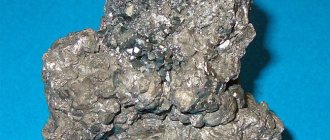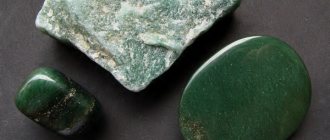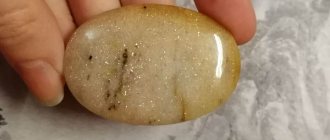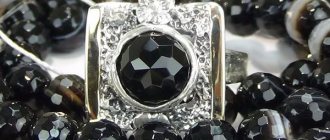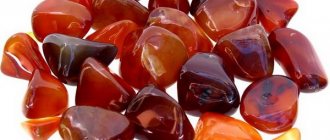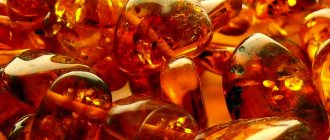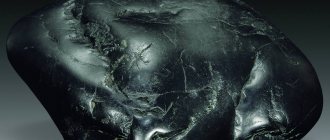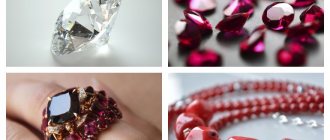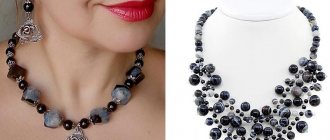Blue aventurine is a variety of aventurine - fine-grained quartzite with various scattered inclusions, which affect the color of the mineral. It owes its blue color to cobalt. Aventurine can also be green, red-brown, or yellow.
Regardless of the shade, the stone has a sparkling shimmering shine due to the inclusion of tiny mica flakes. The brilliant blue color has contributed to the emergence of a large number of myths and legends that surround the mineral.
Aventurine stone: history of the stone
- Aventurine has been known since the times of ancient civilizations. Asian traders believed that this mineral helped increase the strength of people who charmed snakes. It was they who brought this crystal to European countries.
- In Russia, mineral stone appeared in the 17th century. When the deposit was discovered in the Urals, the popularity of jewelry with aventurine increased. It was also used in the manufacture of interior items (vases, boxes, candlesticks, etc.). The crystal was even used in the manufacture of handles for cutlery.
- Now in the Hermitage you can see a vase created several centuries ago. The height of the stone product is about 1.5 m, and the diameter is 2.5 m. A very unusual exhibit of aventurine is presented in the Geological Museum. This vase was presented by Emperor Nicholas I as a gift to the aristocrat Murchison.
Variety of colors
FEATURES OF BLUE MINERAL
Blue aventurine is an opaque mineral, highly polished, hardness – 7, density – 2.5. Its deposits are found in Western Europe, India, the USA, and Australia. In Russia - in the Urals.
The price per gram of blue aventurine is very low - cabochons from it cost between 100-200 rubles, a set of rings and earrings in silver - about 1200-1500, a bracelet - 1400, beads - 1600 rubles. Interestingly, artificial blue aventurine is valued three times more expensive.
Any minerals require cleaning, and blue aventurine is no exception, so there are certain care rules:
- Periodically, products with blue aventurine should be washed in soapy warm water with a soft sponge;
- the use of abrasive and chemical agents is strictly prohibited;
- It is recommended to sometimes expose blue aventurine to the sun for energy recharging;
- It is better to store it in a box with soft upholstery on the inside.
We recommend: GYPSUM - all around us
In addition, jewelry with this aventurine must be “walked” - the mineral will lose its properties if you forget about care.
Authentication
Aventurine stone color
There are many shades of unusual stone. Its magical and healing properties depend on the color of the crystal. Therefore, it is necessary to analyze each of the varieties in detail:
- green aventurine. It is also called "fuchsite". This shade is obtained by using chrome and small mica flakes. Properties of green aventurine - this crystal helps improve a person’s financial well-being. It also has a beneficial effect on fair-haired women. With its help, female representatives will be able to attract love.
Fuchsite
- yellow aventurine. If muscovite is present in the stone, a bright yellow tint will become characteristic. Properties of yellow aventurine - this mineral protects a person from negativity, and also helps to restore physical and emotional strength after a difficult day.
Solar
- cherry aventurine. This shade is given by hematite, which is part of the stone. The crystal helps its owner become confident and calm. It also promotes the development of creative abilities. Therefore, it is worn by artists, performers and actors.
- pink aventurine. Aventurine contains iron, which gives the crystal its unusual shade. If you constantly wear the mineral, you can attract love into your life and find your other half.
Soft color
- black aventurine. The use of such aventurine should be done with extreme caution. It should be worn by those who are afraid of negative influences (damage, evil eye, etc.). Improper use of a crystal contributes to disruption of the human psyche, which causes mental trauma.
Saturated color
- blue aventurine. It is used by those who want to improve relationships with others. In addition, it helps develop public speaking skills.
lovely blue
- red and white. Helps protect against dangerous diseases and strengthens the immune system;
- striped. Promotes the development of creative abilities.
Aventurine: how to distinguish a fake?
- Natural aventurine is very rarely found in stores. Consumers, if they find such an instance, prefer golden-brown crystals.
- Natural specimens have a more subdued shade, without a pronounced shine. It is necessary to carefully examine each stone to determine its naturalness. At the same time, it is difficult for an ordinary person to do this. It's better to consult a specialist.
- For most people, “aventurine” is a few different minerals. Most often it refers to an imitation of glass, which is called “aventurine glass”. It is obtained by adding oxide of iron, cobalt and other elements to the glass mass. It is they who color the mineral in different shades.
- Aventurine imitations have a more presentable appearance. Therefore, buyers give preference to them, even if they know that the product is not natural.
Stone or not?
Recognize a fake product
History of the creation of aventurine imitation
The very first aventurine glass “happened” in the city of Murano, near Venice. And it was a complete surprise. One of the craftsmen spilled metal shavings into molten glass - this is how “aventurine” turned out. Perhaps its name, which is translated from Latin as “chance”, “accident”, is rooted precisely in these days and this history.
There is such a rare optical phenomenon that is called “aventurescence” - it is not for nothing that it is called the same as aventurine itself. This is the effect of radiance, a colorful, shimmering shine, dazzlingly glowing and glittering, sometimes faintly, sometimes intensely. The intensity of the glare depends on how densely located and what size the inclusions of metallic sparkles are. The color of aventurine glass also depends on inclusions. All natural stones, by the way, have distinctive light and dark color zones. Imitations are usually colored evenly.
On topic: Aventurine: description of the stone
Quartz aventurine can sometimes be confused with feldspar aventurine. Feldspar can only be found in nature in red-orange shades and is more transparent than quartz. This makes the stones very easy to distinguish from each other. It can also easily be confused with malachite, jade or jadeite, but only in appearance, since all these stones are softer than quartz aventurine.
Video on the topic: Aventurine and its secrets
Medicinal properties of aventurine
- Experts in the field of stone healing are convinced that aventurine is a healing stone . It has a positive effect on the central nervous system and brain. The only exception is the black variety. Regular use of the mineral helps normalize sleep and balance the emotional background.
- The stone helps in the prevention and treatment of skin diseases, including eczema and psoriasis. To see noticeable positive results, apply the crystal to the affected area several times a day and keep it with you at all times. The use of light-colored stones helps eliminate headaches or toothaches.
- It is believed that aventurine helps cope with diseases of the respiratory system. If you regularly wear a pendant or pendant made of this mineral, you can cure thyroid diseases. Yellow aventurine helps remove kidney stones.
The stone is extremely useful.
Wearing a ring made of this stone helps:
- removing excess fluid from the body
- normalization of body weight
- decreased appetite
Aventurine: magical properties
- In ancient times, aventurine was a talisman for players. It was believed that it helps to attract good luck and fortune. It is also carried by businessmen, sailors and travelers. That is, it is a must have for those people who like to take risks.
- If you have a car, then there must be a magic crystal in the interior. It can be inserted into the transmission or placed in the glove compartment. This will create a favorable atmosphere in the cabin that will protect against accidents.
Magic stone
- Thanks to the reflective surface of aventurine, it helps a person protect himself from premature and violent death . If negative energy is directed at the owner, the mineral will absorb it and reflect it. This means that a person who wishes harm to someone will himself suffer from it.
- With the help of aventurine you can get rid of paranoia, depression and despondency . If a person suffers from constant mood swings, then with the help of this crystal you can get rid of it.
Reasons for imitations
Unfortunately, gone are the days when it was possible to discover a treasured gemstone on a simple path. But the population of our planet is increasing. And along with him, his need for the “star stone” grows. The mineral is used to create jewelry such as brooches, beads, earrings, rings, and pendants. More massive objects of art are not currently produced from this mineral. This is due to the fact that this stone is rarely found in the form of large formations (a formation is considered large if its dimensions are at least half a meter in diameter).
Interesting fact
In the 18th century, aventurine was discovered on the territory of the Southern Urals, the dimensions of which made it possible to carve three vases from it, each of which was 146 cm high and 246 cm wide. One of these vases is still in the State Hermitage Museum (city) . Saint Petersburg).
What to choose: aventurine or aventurine glass
If you set out to purchase jewelry made from real aventurine, you should be prepared for the following:
- its color will not be bright (most often aventurines have a weak color of the grains);
- blisters of natural aventurine are located unevenly in space and differ in the degree of gloss;
- large formations of aventurine are rare, and, therefore, the price of products made from it is high.
Now regarding aventurine glass. Although it is a counterfeit of aventurine, it also has its advantages:
- The first plus is the price. Compared to the cost of natural aventurine, the cost of its analogue is relatively low.
- The second plus is the color scheme. Thanks to modern advances in glassmaking, the creators of aventurine glass can give it any color required by the customer.
- Plus the third is the brightness of the shine. If you want to get a piece of jewelry that resembles the light of distant stars, you should also consider aventurine glass. The fact is that in the original the sparkles are scattered chaotically and rarely form “star” clusters.
- Plus the fourth one is size. Due to the low cost of star glass and the ease of its processing, you can order products from manufacturers, the size of which is limited only by the capabilities of your wallet. This could be a perfume bottle for your beloved woman or a life-size statue of yourself. It's up to you to choose.
Future prospects
Everyone knows that scientific and technological progress is not used to standing still. That is why attempts to recreate the structure of the “adventurous” mineral will continue.
According to the information we have, experiments are currently being conducted to fuse quartzite grains with the addition of blisters found in natural stone. If the experiment is completed successfully, then soon we will find an artificial stone that is not inferior to the best (jewelry) samples of the original.
You saw a photo of the mineral in the article, but there is also a video that shows the original and fake aventurine next to each other, which helps to clearly understand this issue:
Well, we talked about aventurine and how to choose it. In other articles on our site we will tell you about:
- fire opals;
- sun and moon stones;
- petrified wood;
- marble onyx;
- jasper;
- and other equally amazing stones.
In the meantime, we invite you to subscribe to updates on our constantly expanding site and invite your friends to it by reposting this or any other article on social networks. We hope to see you soon!
Team LyubiKamni
With the development of technology and science, scientists have learned to imitate natural stones. They can be grown in laboratory conditions, or made from glass, plastic and other materials. Of course, no self-respecting jewelry store will deceive you and indicate on the tag what you are dealing with. But a completely different matter are scammers who can pass off a fake as a natural mineral. This also applies to aventurine, which is popular among lovers of jewelry and simply natural crystals. How to avoid falling for deception and distinguish fake aventurine?
Aventurine: who suits your zodiac sign?
- Not all zodiac signs can wear aventurine. For some of them, it can be a source of trouble. The stone is ideal for Taurus and Virgo . It will help its owner find love and improve their financial situation.
- The crystal can be worn by Gemini, Cancer, Libra, Scorpio, Capricorn, Aquarius and Pisces . The stone helps these zodiac signs to strengthen their intuition and develop the best traits in their character.
- Aries, Leo and Sagittarius should not wear the gem . These zodiac signs are overly emotional. The use of the mineral will only increase a person’s hot-tempered temperament, which can cause him a lot of trouble in life.
is not suitable for all signs
- it is a very common stone, but artificial specimens are most often found. Despite this, the crystal fits perfectly into jewelry compositions and helps a person improve his life. But, the magical and healing properties are revealed by constantly wearing the mineral. The gem is ideal for strong personalities who do not give up when faced with the blows of fate.
We will also talk about such stones as:
- Amber
- Chrysoprase
- Agate
- Chrysolite
- Cornelian
- Aquamarine
History of the origin of the mineral
Blue aventurine is a stone associated with legends and beliefs. According to one of them, before finding a natural mineral, people learned to make an imitation of it by accidentally dropping a metal cat into an alloy of colored glass.
When scientists found natural crystals that looked like hand-made glass, they were given the name aventurine, which means “adventure” and “chance.”
There is also a legend that blue aventurine was the talisman of the famous adventurer Cagliostro. His fortune left him as soon as he lost his amulet.
Blue aventurine is a rock formed when clay and sand are compacted into quartzites and crystalline schists.
